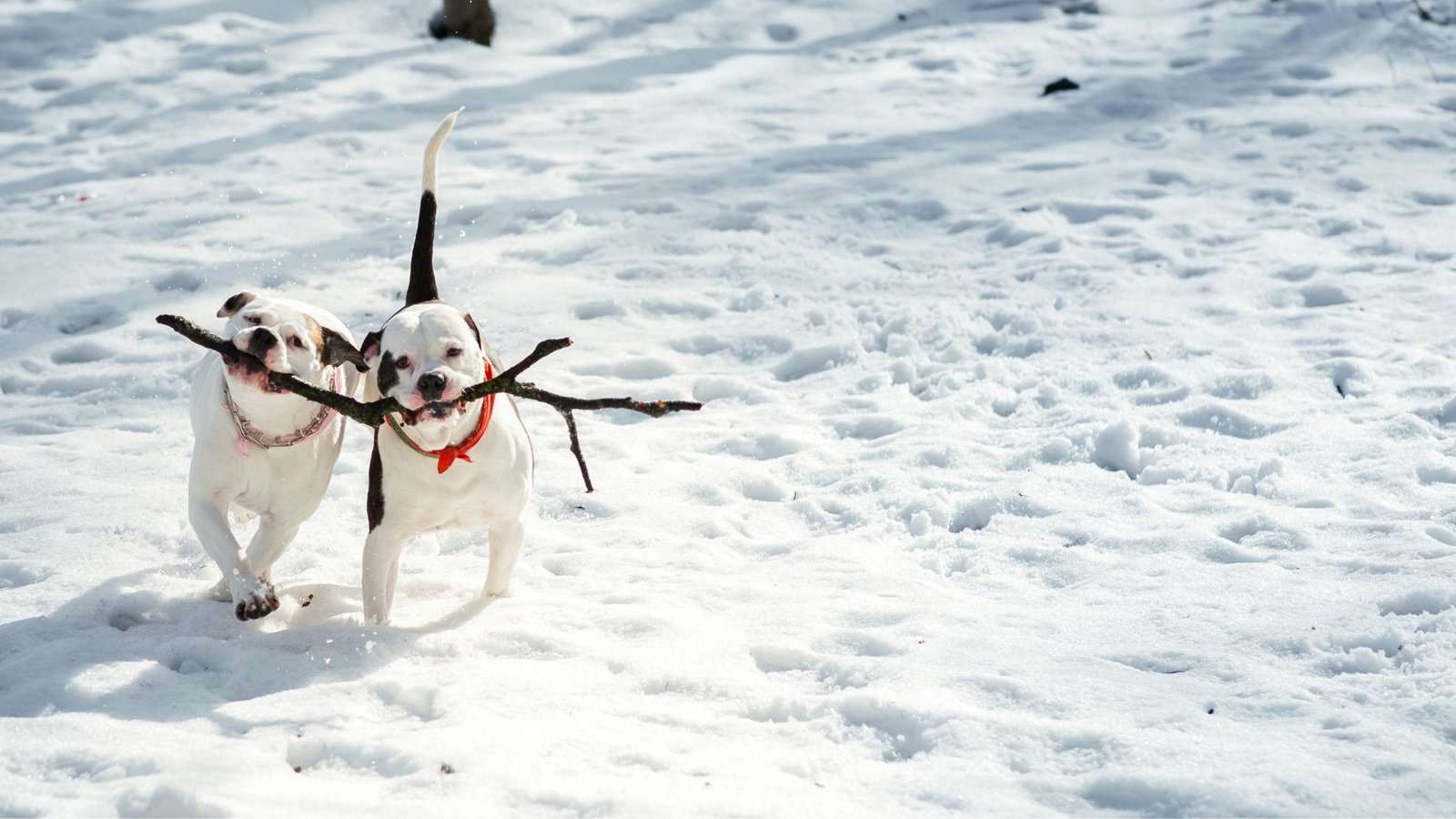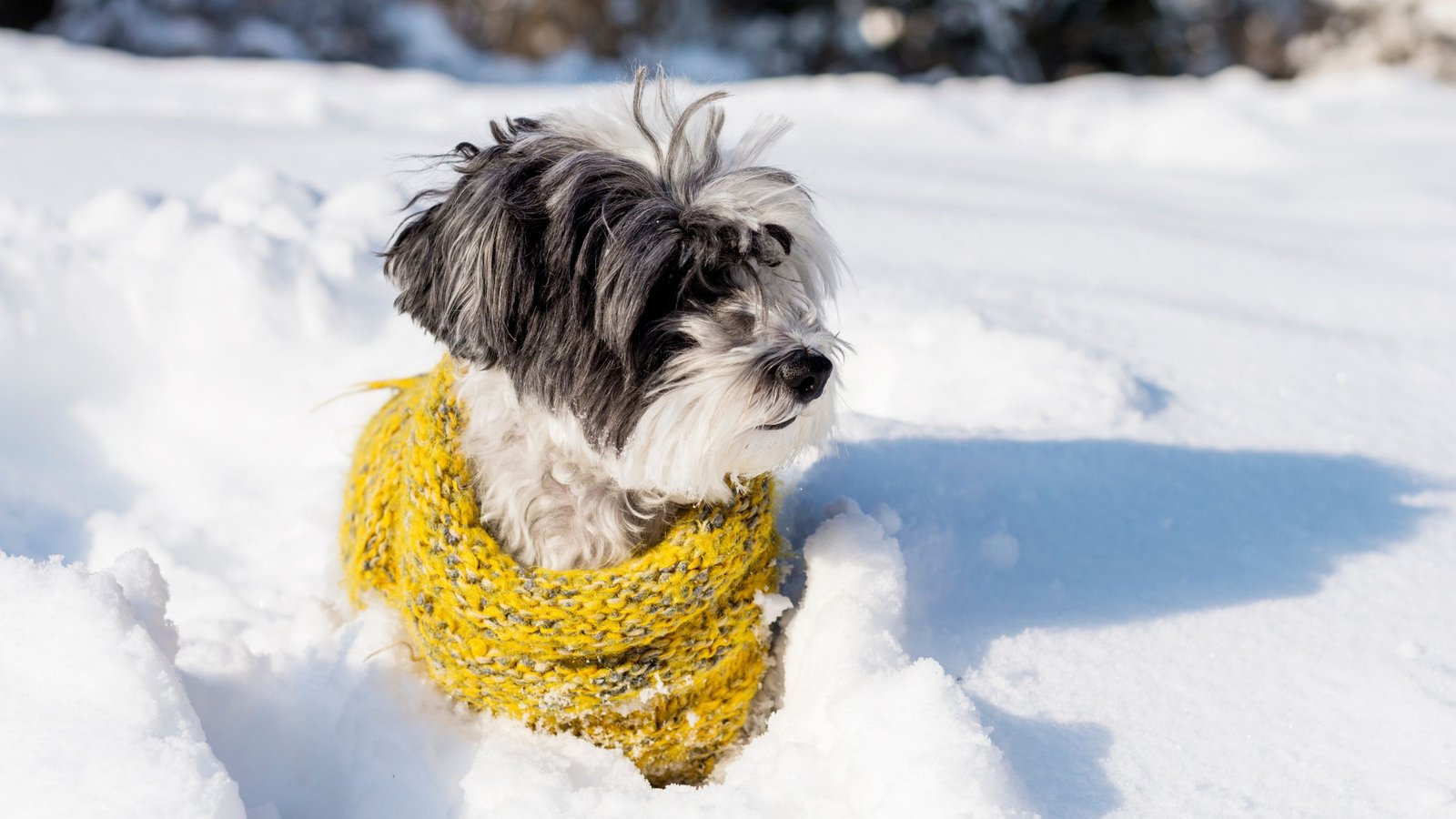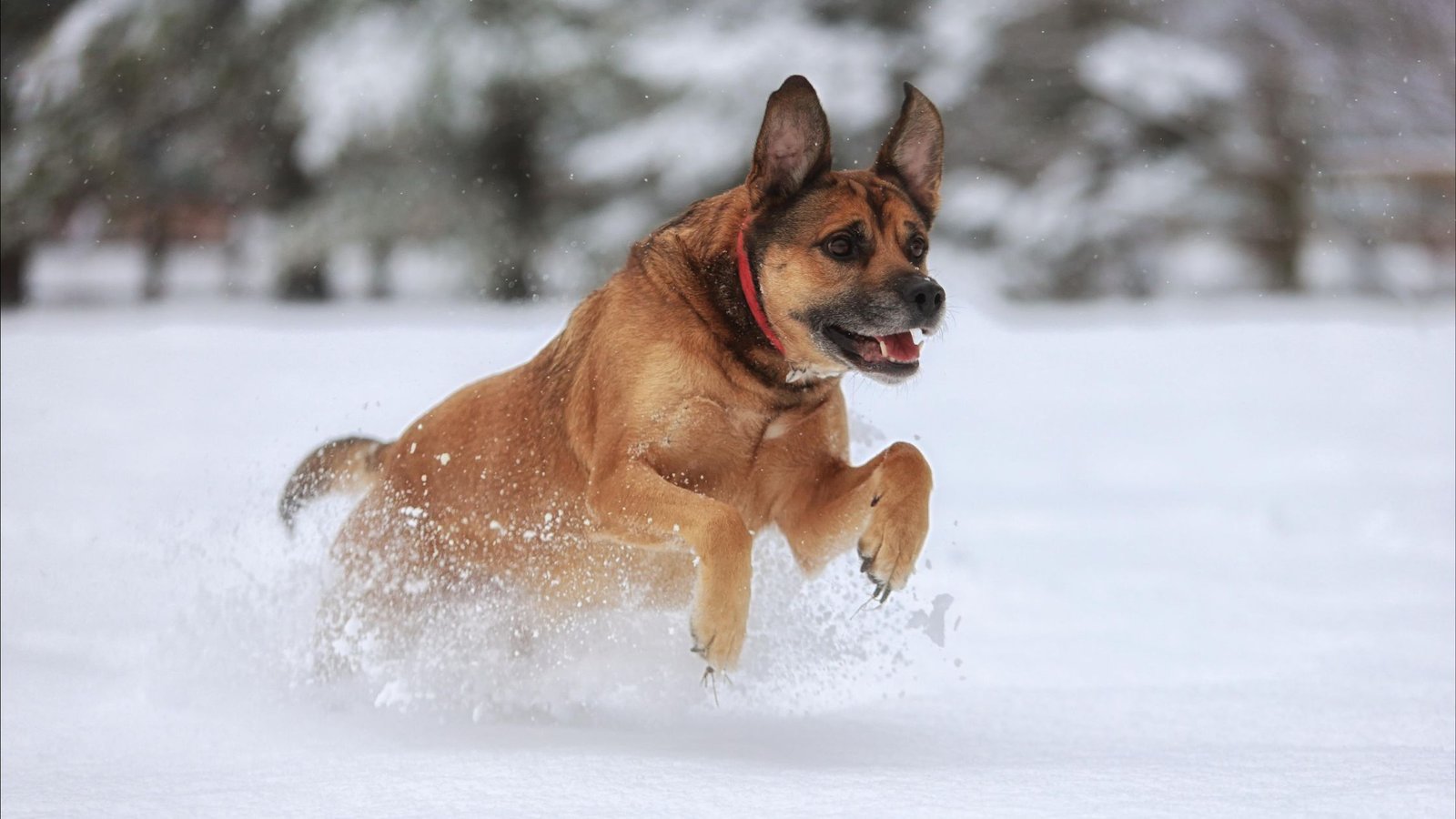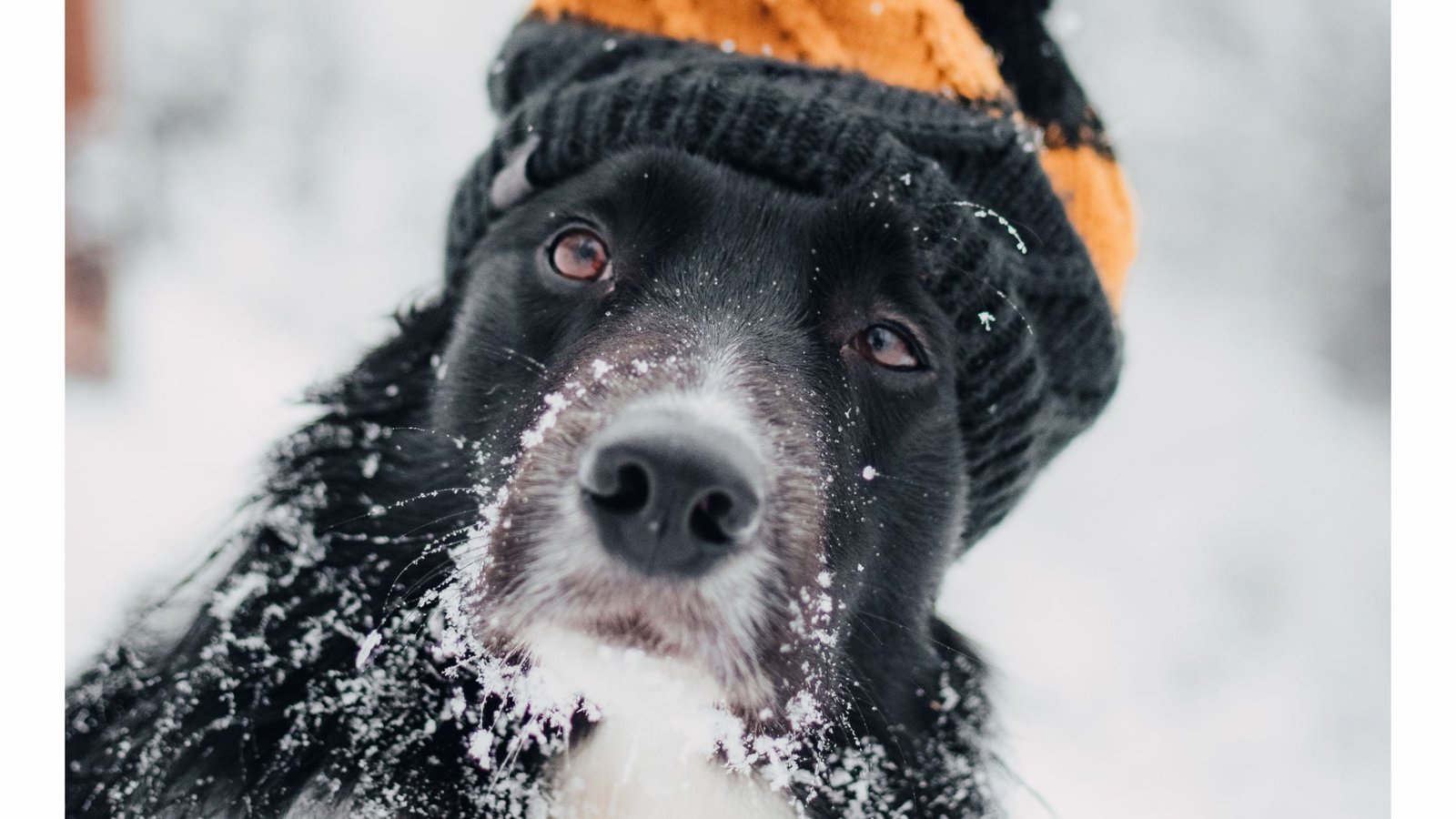As winter blankets the world in a glistening layer of frost, our thoughts naturally turn to keeping warm and snug. In the midst of our own preparations, it’s crucial not to overlook the furry members of our families who depend on us for their well-being, our beloved dogs. Almost as humans, they need to be warm to stay healthy. So, let’s jump on the topic of how to keep your dog warm during the winter?
In this article, we’ll explore the various strategies and thoughtful considerations to ensure your dog stays warm, comfortable, and happy during the chilly winter months. It’s important to know how to keep your dog warm in winter!

UNDERSTANDING YOUR DOG’S BREED AND INDIVIDUAL NEEDS
Each dog breed has its own unique characteristics and tolerance to cold weather.
Some breeds, such as Huskies and Saint Bernards, are well-equipped to handle colder temperatures due to their thick double coats. On the other hand, smaller dog breeds and those with short hair may require extra protection. Older dogs, puppies, and those with certain health conditions may be more susceptible to the cold. Consult with your veterinarian to understand any specific requirements your dog may have.
To Keep Your Dog Warm Try Dressing Them in Winter Apparel
When the temperature drops, it’s a good idea to invest in some winter clothing for your dog. Coats, sweaters, and boots can provide an extra layer of insulation and protect your dog from the cold, wind, and snow. Ensure that the clothing fits properly and doesn’t restrict your dog’s movement or ability to relieve themselves.
Remember, not all dogs enjoy wearing clothing, so it’s essential to introduce it gradually and observe your dog’s comfort level. If your dog shows signs of distress or discomfort, it may be best to find alternative ways to keep them warm.
Creating a Warm and Cozy Indoor Environment
While dogs may enjoy spending time outdoors, it’s crucial to provide them with a warm and cozy indoor environment during the winter months. Always check that your home is well-insulated and don’t got any drafts. Consider using door draft stoppers and window insulation film to keep the cold air out.
Provide your dog with a comfortable bed or blanket in a warm area of the house. Elevating the bed slightly off the floor can help prevent cold drafts from reaching your dog. Additionally, you may want to consider using a heated pet bed or a heating pad designed specifically for pets. This will help to keep your dog warm during winter.
Adjusting Your Dog’s Diet and Hydration
In colder weather, dogs may require more calories to maintain their body temperature. Consult with your veterinarian to determine if your dog’s diet needs to be adjusted during the winter months. Do not forget one of the most important rule as a dog owner, that your dog has access to fresh water at all times. Consider using a heated water bowl to prevent the water from freezing.
Keeping Your Dog Active and Engaged
Regular exercise is essential for your dog’s physical and mental well-being, even during the winter months. However, it’s important to take precautions to keep your dog safe from the cold. Limit outdoor activities during extreme weather conditions, and always check your dog’s paws for signs of cold-related injuries, such as cracked paw pads or ice balls between the toes.
If the weather is too harsh for outdoor activities, engage your dog in indoor games, puzzle toys, or training sessions to keep them mentally stimulated and physically active. Being active will also keep your dog warm during the winter.
Grooming and Paw Care
Proper grooming is crucial during the winter months. Regular brushing helps remove dead hair and promotes better air circulation through your dog’s coat. This is especially important for breeds with longer hair that may become matted or tangled due to snow and ice.
Pay close attention to your dog’s paws. Snow, ice, and de-icing chemicals can cause irritation and dryness. After walks, wipe your dog’s paws with a warm, damp cloth to remove any debris or chemicals. Consider using pet-safe paw balms or booties to provide extra protection.
Dog Safety Precautions
Winter poses unique safety hazards for dogs. Antifreeze, which contains ethylene glycol, can be deadly if ingested. Ensure that all antifreeze containers are securely stored and clean up any spills immediately. Consider using pet-friendly antifreeze alternatives.
Additionally, be cautious when walking near frozen bodies of water. Thin ice can be dangerous and potentially lead to accidents. Keep your dog on a leash and avoid areas with uncertain ice conditions. By following these strategies and thoughtful considerations, you can ensure that your dog stays warm, comfortable, and happy during the chilly winter months.

TRY TO KEEP A WARM HOME: HOW TO CREATE WINTER COMFORT FOR YOUR DOG?
When the winter months roll in, it is crucial to ensure that your dog has a comfortable and warm shelter to retreat to. Whether your dog lives indoors or outdoors, their sleeping arrangements play a significant role in their overall well-being during the colder season.
Providing a cozy den for your furry friend not only helps them stay warm but also taps into their natural nesting instincts. Dogs have an innate desire to find a safe and secure spot where they can curl up and rest. By creating a winter sanctuary that caters to these instincts, you can ensure that your dog stays comfortable and content throughout the winter months.
Indoor Sleeping Arrangements
If your dog lives indoors, it is essential to assess their current sleeping arrangements and make any necessary adjustments to ensure their comfort during winter. First and foremost, designate a specific area for your dog’s bed or crate. This provides them with a sense of ownership and security.
Place their bed or crate in a warm and draft-free area of your home, away from cold windows or doors. Consider investing in a cozy dog bed that provides adequate insulation and cushioning. Look for beds made from materials such as memory foam or thermal fabrics that retain heat. These beds offer extra warmth and support, making them ideal for colder temperatures.
Additionally, you can provide your dog with blankets or a heated pet pad to snuggle up to. Just like humans, dogs appreciate the extra warmth and coziness these items provide. However, be cautious when using heated pads and ensure they have a thermostat control to prevent overheating.
Outdoor Shelter Options
If your dog spends a significant amount of time outdoors or lives exclusively outdoors, it is crucial to provide them with a well-insulated shelter that protects them from the elements. When it comes to outdoor shelters, there are various options available.
One popular choice is a doghouse – a small structure specifically designed for dogs to seek shelter in. When selecting a doghouse, consider the size of your dog and choose one that allows them to stand up, turn around, and lie down comfortably.
Insulation is key when it comes to outdoor shelters. Look for doghouses with thick walls and a raised floor to prevent cold air and moisture from seeping in. You can further enhance insulation by adding blankets, straw, or cedar shavings to create a cozy and warm bedding area.
Another option is a heated outdoor shelter. These shelters come with built-in heating elements that provide a constant source of warmth to your dog. However, ensure that the heating element is safe and does not pose a fire hazard. Regularly check the shelter for any signs of wear and tear or malfunctioning heating elements.
Winterizing Your Dog’s Outdoor Space
In addition to providing a suitable shelter, there are other measures you can take to winterize your dog’s outdoor space and ensure their comfort. Firstly, create a windbreak around the shelter to minimize cold drafts. This can be achieved by placing a tarp or windbreak fencing around the perimeter of the shelter.
Ensure that the windbreak is securely fastened and does not pose any risks to your dog. Next, elevate the shelter off the ground to prevent cold air and moisture from seeping in. Placing the shelter on a pallet or platform helps create an additional barrier against the cold ground. Regularly check and clean the shelter to ensure it remains dry and free from any debris.
Wet bedding can quickly become cold and uncomfortable for your dog, so it is essential to keep their sleeping area clean and dry. Furthermore, provide your dog with fresh, unfrozen water at all times. Consider using heated water bowls or investing in heated water dispensers to prevent freezing during colder temperatures.
Monitoring Your Dog’s Comfort
While you may have created a cozy den for your dog, it is essential to monitor their comfort throughout the winter season. Keep an eye out for signs of discomfort or distress, such as excessive shivering, reluctance to go outside, or seeking warmth in unusual places.
These signs may indicate that your dog is not adequately protected from the cold and may require adjustments to their sleeping arrangements or additional measures to keep them warm. Regularly check your dog’s bedding for any signs of dampness or cold spots. Replace wet or soiled bedding promptly to ensure their comfort and prevent them from getting chilled.
Lastly, remember that each dog is unique, and their cold tolerance may vary. Some breeds are more suited to colder climates, while others may require extra measures to stay warm. Observe your dog’s needs and make adjustments accordingly.
The Cozy Path to Dog Contentment
Creating a winter sanctuary for your dog is essential to ensure their comfort and well-being during the colder months. Whether your dog lives indoors or outdoors, providing a cozy den with warm bedding and insulated shelter options is crucial. Assess your dog’s current sleeping arrangements and make any necessary adjustments to enhance their comfort.
Consider investing in a cozy dog bed, blankets, or a heated pet pad for indoor sleeping arrangements. For outdoor shelter, choose a well-insulated doghouse or a heated outdoor shelter and winterize the space with windbreaks and elevated flooring. Monitor your dog’s comfort throughout the winter season and make any necessary changes to their sleeping arrangements or additional measures to ensure their warmth.

DOG EXERCISE AND MENTAL STIMULATION
As winter settles in, we find ourselves spending more time indoors, seeking warmth and comfort. But what about our furry friends? Our dogs also need mental stimulation to keep their minds sharp and prevent boredom.
Let’s explore enrichment activities and brain games that can help keep your dog mentally active and content throughout the winter season.
Why is Mental Stimulation Important for Dogs?
Dogs need mental exercise to stay happy and healthy as much as anybody else. Mental stimulation can help prevent behavioral problems that often arise from boredom, such as excessive chewing, digging, or barking. It also provides an outlet for their natural instincts and can help build their problem-solving skills.
During the winter months, when outdoor activities may be limited, it becomes even more crucial to find ways to keep our dogs mentally engaged. So, let’s dive into some fun and stimulating activities that you can incorporate into your dog’s routine.
How to Keep Your Dog Warm in Winter with Interactive Toys and Puzzle Games?
One of the easiest ways to provide mental stimulation for your dog is through interactive toys and puzzle games. These toys are designed to challenge your dog’s problem-solving abilities and keep them entertained for hours. There are various types of interactive toys available in the market, such as treat-dispensing toys, puzzle balls, and hide-and-seek games.
These toys require your dog to think and strategize in order to access the treats or solve the puzzle. Not only do they provide mental stimulation, but they also help keep your dog physically active. If you’re feeling crafty, you can even make your own DIY puzzle toys using household items. For example, you can hide treats in a muffin tin and cover each compartment with tennis balls. Get creative and see what kind of puzzles you can come up with!
Dog Training and Tricks to Keep Your Dog Warm in Winter
Training sessions are not only a great way to teach your dog new skills but also provide mental stimulation. Dogs love to learn and please their owners, so engaging in training sessions can be both mentally and emotionally rewarding for them. You can teach your dog simple tricks like “sit,” “stay,” or “shake hands.”
These tricks not only stimulate their minds but also strengthen the bond between you and your furry friend. You can also take it a step further and enroll your dog in advanced training classes or agility courses. These activities challenge their problem-solving abilities and keep them mentally sharp.
How to Keep Your Dog Warm in Winter with Scent Games and Nose Work?
Dogs have an incredible sense of smell, and engaging in scent games and nose work can provide them with a great mental workout. You can start by hiding treats or toys around the house and encouraging your dog to find them using their nose. This kind of games taps into their natural ancestral hunting instincts and keeps them mentally stimulated.
If your dog enjoys scent games, you can take it to the next level by participating in scent work classes or competitions. These activities involve searching for specific scents in various environments, providing a challenging mental exercise for your dog.
Rotate Toys and Activities to Keep Your Dog Warm in Winter
Just like humans, dogs can get bored with the same toys and activities day after day. To keep their minds engaged, it’s important to rotate their toys and activities regularly. This prevents them from becoming too familiar with their surroundings and keeps them curious and interested.
Introduce new toys and puzzles every few days and put away the ones they have already played with. This way, when you bring out an old toy after a few weeks, it will feel new and exciting to them again. You can also switch up their daily routine by taking different routes on your walks or exploring new parks and trails. Winter may bring colder temperatures and more time spent indoors, but it doesn’t have to mean boredom for your furry friend.
By incorporating mental stimulation activities into your dog’s routine, you can ensure they stay mentally active and content throughout the winter season. From interactive toys and puzzle games to training sessions and scent work, there are plenty of options to keep your dog’s mind sharp and engaged. Games would also keep warm your dog in the winter!

DOGS COMBATING WINTER DEHYDRATION
Contrary to common belief, staying hydrated is as crucial in winter as it is in summer. While we tend to associate dehydration with hot weather and excessive sweating, the colder temperatures of winter can also pose a risk for dehydration, both for humans and our furry friends.
Let’s focus on dogs and why they may be prone to dehydration in colder weather. We will also provide practical tips to ensure your dog drinks enough water to stay healthy and hydrated throughout the winter season.
Understanding Dehydration in Dogs
Dehydration occurs when there is an imbalance between the amount of water a dog takes in and the amount they lose through various bodily functions.
In winter, dogs may be more prone to dehydration due to several factors:
- Decreased water intake: Dogs may naturally drink less water in colder weather. This can be due to a decreased thirst drive or the perception that they do not need as much water when it is not hot outside.
- Increased water loss: Cold weather can cause dogs to shiver, which increases their metabolic rate and, in turn, their water loss through respiration and evaporation.
- Dry indoor air: The use of heaters indoors can lead to dry air, which can contribute to dehydration in dogs.
How to Ensure Your Dog Drinks Enough Water and Stays Warm in Winter?
The first three tips to ensure your dog drink enough water and stay hydrated are adjusting water temperatures, providing fresh water at all times and incorporating hydrating treats. In winter, dogs may be more reluctant to drink cold water. To encourage them to stay hydrated, consider offering them lukewarm or room temperature water.
This can make drinking more appealing and help prevent them from avoiding water altogether. Make sure your dog has access to fresh water throughout the day. Check their water bowl regularly and refill it as needed. If you notice that your dog’s water bowl is freezing, consider using a heated water bowl or replacing the water more frequently to prevent it from freezing.
Hydrating treats can be a great way to supplement your dog’s water intake. Look for treats that have a high moisture content, such as watermelon or cucumber slices, or consider using frozen treats made with low-sodium chicken broth. These treats not only provide hydration but also offer a refreshing and tasty snack for your dog.
Three More Steps To Make To Keep Your Dog Hydrated and Warm in Winter
The three important steps you need to make to keep your dog hydrated and warm during winter are to use interactive water bowls, monitor your dog’s water intake and limit exposure to dry indoor air. Some dogs may find drinking from a regular water bowl boring. Consider using interactive water bowls or fountains that provide a constant flow of water.
The movement and sound of flowing water can attract your dog’s attention and encourage them to drink more. Keep an eye on how much water your dog is drinking each day. If you notice a significant decrease in their water intake or signs of dehydration, such as dry gums, sunken eyes, or lethargy, consult your veterinarian for further guidance.
They may recommend additional measures to ensure your dog stays properly hydrated. While it may be necessary to use heaters indoors during winter, try to limit your dog’s exposure to dry air. Use a humidifier to add moisture to the air or place a bowl of water near the heater to help increase humidity. This can help prevent excessive water loss through respiration and keep your dog’s body hydrated.
Incorporate Hydrating Treats
Winter dehydration in dogs is a real concern that pet owners should not overlook. By understanding the factors that contribute to dehydration in colder weather and implementing practical tips to ensure your dog drinks enough water, you can help keep your furry friend healthy and hydrated throughout the winter season.
Remember to adjust water temperatures, provide fresh water at all times, incorporate hydrating treats, use interactive water bowls, monitor your dog’s water intake, and limit exposure to dry indoor air. By taking these simple steps, you can combat winter dehydration and ensure your dog’s internal furnace burns brightly all season long.
Final Thoughts About how to keep your dog warm in winter
So, embrace the cozy path to dog contentment and enjoy the winter season with your happy and mentally stimulated pup! Remember that each dog is unique, and their cold tolerance may vary, so pay attention to their individual needs. By creating a cozy winter sanctuary for your dog, you can provide them with a safe and comfortable space where they can rest and stay warm during the colder months.
Remember to understand your dog’s breed and individual needs, dress them in appropriate winter apparel, create a warm indoor environment, adjust their diet and hydration, keep them active and engaged, prioritize grooming and paw care, and take necessary safety precautions. With your love and care, your dog will be warm during the winter and be able to enjoy the winter season to the fullest. This article will help you to keep your dog warm in winter!
While on this topic about the winter, we want to recommend to read about the winter working dogs, also called the SLED DOGS!









